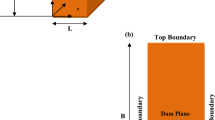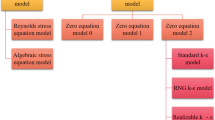Abstract
A numerical model is proposed to simulate the unsteady seepage flow through dam, with both saturation and water head as variables to describe the seepage domain. Experiments of seepage flow through dam with unsteady conditions were conducted in laboratory to verify the reliability and the accuracy of the numerical model. The performance of the model is also assessed by comparing with analytical solutions. The examples show that the accuracy and the reliability of the model are adequate to handle seepage flow problems with complex conditions. It is also demonstrated that the method of determining the seepage surface through the saturation description is natural, logical and practical in actual applications. The method provides a relatively simple computing scheme, as compared with traditional methods.
Similar content being viewed by others
References
PENG Hua, CHEN Sheng-hong. Finite element analyses of unstable seepage in saturated-unsaturated rock[J]. Journal of Hydrodynamics, Ser. A, 2002, 17(2): 253–259(in Chinese).
ZHANG Xin-hua, ZHANG Xiang-wei and WANG Hua et al. Coupled simulation the effect of tailings stack on groundwater and groundwater quality[J]. Journal of Hydrodynamics, Ser. A, 2007, 22(5): 654–664(in Chinese).
ATAIE-ASHTIANI B., VOLKER R. E. and LOCKINGTON D. A. Tidal effects on sea water intrusion in unconfined aquifers[J]. Journal of Hydrology, 1999, 216(1–2): 17–31.
HOU Jian, ZHANG Shun-kang and DU Qing-jun et al. A streamline-based predictive model for enhanced-oil-recovery potentiality[J]. Journal of Hydrodynamics, 2008, 20(3): 314–322.
CHEN Sheng-hong, WANG Wei-ming and SHE Cheng-xue et al. Unconfined seepage analysis of discontinuous rock slope[J]. Journal of Hydrodynamics, Ser. B, 2000, 12(3): 75–86.
ADIL Elkrail, SHU Long-cang and HAO Zhen-chun. Numerical simulation of groundwater dynamics for Songhuajiang River valley in China[J]. Journal of Hydrodynamics, Ser. B, 2004, 16(3): 332–335.
ZHOU Zhi-fang, GUO Geng-xin. Numerical modeling for positive and inverse problem of 3D seepage in double fractured media[J]. Journal of Hydrodynamics, Ser. B, 2005, 17(2): 186–193.
GE Jin-hong, LI Guang-xin and JIE Yu-xin. Application of element-free method to the seepage calculation with free surface[J]. Chinese Journal of Computational Mechanics, 2003, 20(2): 241–243(in Chinese).
CHEN Chang-lu, PAN Wen-yan and WANG Xiao-zhang. Variable element seepage coefficient method for seepage numerical analysis with free surface[J]. Geotechnical Engineering Technique, 2005, 19(4): 166–169(in Chinese).
ZHANG Qian-fei, WANG Yan-ming. Research on improved cut-off negative pressure method for unsteady seepage flow with free surface[J]. Journal of Hydrodynamics, Ser. B, 2005, 17(5): 521–531.
HUA Lei-na, YU Xi-ping. An enhanced element-free Galerkin method for dynamic response of poroelastic seabed[J]. Journal of Hydrodynamics, 2009, 21(3): 429–435(in Chinese).
SUN Dong-mei, ZHU Yue-ming and ZHANG Ming-jin. Water-air two-phase flow model for numerical analysis of rainfall infiltration[J]. Journal of Hydraulic Engineering, 2007, 38(2): 150–156(in Chinese).
SUN Dong-mei, ZHU Yue-ming and ZHANG Ming-jin. Unsteady seepage problems due to water level fluctuation[J]. Journal of Tianjin University, 2007, 40(7): 779–785(in Chinese).
LOCKINGTON D. A. Response of unconfined aquifer to sudden change in boundary head[J]. Journal of Irrigation and Drainage Engineering, 1997, 123(1): 24–27.
ATAIE-ASHTIANI B., VOLKER R. E. and LOCKINGTON D. A. Numerical and experimental study of seepage in unconfined aquifers with a periodic boundary condition[J]. Journal of Hydrology, 1999, 222(1-4): 165–184.
ROSS P. J. Modeling soil water and solute transport-fast, simplified numerical solutions[J]. Agron. J., 2003, 95(6): 1352–1361.
VARADO N., BRAUD I. and ROSS P. J. et al. Assessment of an efficient numerical solution of the 1D Richards’ equation on bare soil[J]. Journal of Hydrology, 2006, 323(1–4): 244–257.
LI Hai-long, MICHEL C. B. and JAMES W. W. Tide-induced seawater-groundwater circulation in shallow beach aquifers[J]. Journal of Hydrology, 2008, 352(1–2): 211–224.
JIN Sheng, GENG Yan-fen and WANG Zhi-li. Computation of seepage flow of dam’s free surface by using saturated-unsaturated model[J]. Journal of Dalian University of Technology, 2004, 44(1): 110–113(in Chinese).
TULI A., HOPMANS J. W. Effect of degree of fluid saturation on transport coefficients in disturbed soils[J]. European Journal of Soil Science, 2004, 55(1): 147–164.
PETER L., FRITZ S. and CHRISTOPH H. et al. Effect of hysteresis on water flow in a sand column with a fluctuating capillary fringe[J]. Journal of Contaminant Hydrology, 1998, 33(1–2): 81–100.
KEVIN D. P., IAN R. F. Evaluation of a geosynthetic capillary barrier[J]. Geotextiles and Geomembranes, 2006, 24(1): 64–71.
MUALEM Y. A new model for predicting the hydraulic conductivity of unsaturated porous media[J]. Water Resources Research, 1976, 12(3): 513–522.
Van GENUCHTEN M. T. A closed-form equation for predicting the hydraulic conductivity of unsaturated soils[J]. Soil Science Society of America Journal, 1980, 44(5): 892–898.
BEAUGENDRE H., ERN A. A seepage face model for the interaction of shallow water tables with the ground surface: Application of the obstacle-type method[J]. Journal of Hydrology, 2006, 329(1–2): 258–273.
BATHE K. J. Finite element method in engineering analysis[M]. New York: McGraw-Hill, 1986.
Author information
Authors and Affiliations
Corresponding author
Additional information
Biography: FU Jun-feng (1978-), Male, Ph. D.
Rights and permissions
About this article
Cite this article
Fu, Jf., Jin, S. A Study on Unsteady Seepage Flow Through Dam. J Hydrodyn 21, 499–504 (2009). https://doi.org/10.1016/S1001-6058(08)60176-6
Received:
Revised:
Published:
Issue Date:
DOI: https://doi.org/10.1016/S1001-6058(08)60176-6




